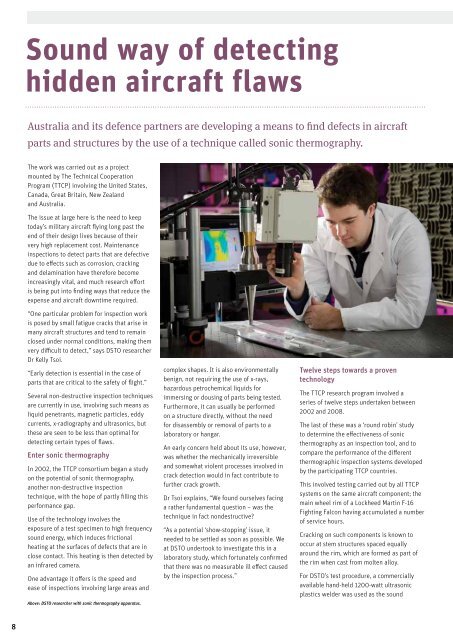DSA Volume 1 Issue 4 December 2010 - Defence Science and ...
DSA Volume 1 Issue 4 December 2010 - Defence Science and ...
DSA Volume 1 Issue 4 December 2010 - Defence Science and ...
You also want an ePaper? Increase the reach of your titles
YUMPU automatically turns print PDFs into web optimized ePapers that Google loves.
Sound way of detecting<br />
hidden aircraft flaws<br />
Australia <strong>and</strong> its defence partners are developing a means to find defects in aircraft<br />
parts <strong>and</strong> structures by the use of a technique called sonic thermography.<br />
The work was carried out as a project<br />
mounted by The Technical Cooperation<br />
Program (TTCP) involving the United States,<br />
Canada, Great Britain, New Zeal<strong>and</strong><br />
<strong>and</strong> Australia.<br />
The issue at large here is the need to keep<br />
today’s military aircraft flying long past the<br />
end of their design lives because of their<br />
very high replacement cost. Maintenance<br />
inspections to detect parts that are defective<br />
due to effects such as corrosion, cracking<br />
<strong>and</strong> delamination have therefore become<br />
increasingly vital, <strong>and</strong> much research effort<br />
is being put into finding ways that reduce the<br />
expense <strong>and</strong> aircraft downtime required.<br />
“One particular problem for inspection work<br />
is posed by small fatigue cracks that arise in<br />
many aircraft structures <strong>and</strong> tend to remain<br />
closed under normal conditions, making them<br />
very difficult to detect,” says DSTO researcher<br />
Dr Kelly Tsoi.<br />
“Early detection is essential in the case of<br />
parts that are critical to the safety of flight.”<br />
Several non-destructive inspection techniques<br />
are currently in use, involving such means as<br />
liquid penetrants, magnetic particles, eddy<br />
currents, x-radiography <strong>and</strong> ultrasonics, but<br />
these are seen to be less than optimal for<br />
detecting certain types of flaws.<br />
Enter sonic thermography<br />
In 2002, the TTCP consortium began a study<br />
on the potential of sonic thermography,<br />
another non-destructive inspection<br />
technique, with the hope of partly filling this<br />
performance gap.<br />
Use of the technology involves the<br />
exposure of a test specimen to high frequency<br />
sound energy, which induces frictional<br />
heating at the surfaces of defects that are in<br />
close contact. This heating is then detected by<br />
an infrared camera.<br />
One advantage it offers is the speed <strong>and</strong><br />
ease of inspections involving large areas <strong>and</strong><br />
Above: DSTO researcher with sonic thermography apparatus.<br />
complex shapes. It is also environmentally<br />
benign, not requiring the use of x-rays,<br />
hazardous petrochemical liquids for<br />
immersing or dousing of parts being tested.<br />
Furthermore, it can usually be performed<br />
on a structure directly, without the need<br />
for disassembly or removal of parts to a<br />
laboratory or hangar.<br />
An early concern held about its use, however,<br />
was whether the mechanically irreversible<br />
<strong>and</strong> somewhat violent processes involved in<br />
crack detection would in fact contribute to<br />
further crack growth.<br />
Dr Tsoi explains, “We found ourselves facing<br />
a rather fundamental question – was the<br />
technique in fact nondestructive?<br />
“As a potential ‘show-stopping’ issue, it<br />
needed to be settled as soon as possible. We<br />
at DSTO undertook to investigate this in a<br />
laboratory study, which fortunately confirmed<br />
that there was no measurable ill effect caused<br />
by the inspection process.”<br />
Twelve steps towards a proven<br />
technology<br />
The TTCP research program involved a<br />
series of twelve steps undertaken between<br />
2002 <strong>and</strong> 2008.<br />
The last of these was a ‘round robin’ study<br />
to determine the effectiveness of sonic<br />
thermography as an inspection tool, <strong>and</strong> to<br />
compare the performance of the different<br />
thermographic inspection systems developed<br />
by the participating TTCP countries.<br />
This involved testing carried out by all TTCP<br />
systems on the same aircraft component; the<br />
main wheel rim of a Lockheed Martin F-16<br />
Fighting Falcon having accumulated a number<br />
of service hours.<br />
Cracking on such components is known to<br />
occur at stem structures spaced equally<br />
around the rim, which are formed as part of<br />
the rim when cast from molten alloy.<br />
For DSTO’s test procedure, a commercially<br />
available h<strong>and</strong>-held 1200-watt ultrasonic<br />
plastics welder was used as the sound<br />
8

















